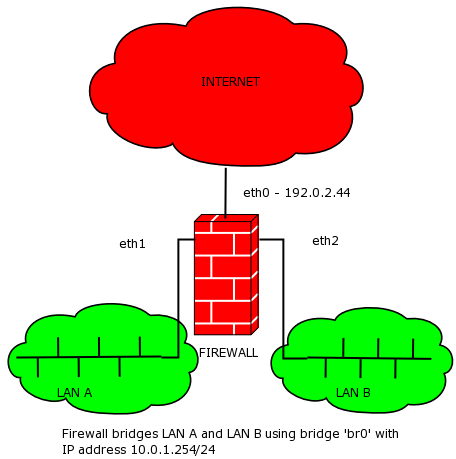Copyright © 2004, 2005, 2006 Thomas M. Eastep
Permission is granted to copy, distribute and/or modify this document under the terms of the GNU Free Documentation License, Version 1.2 or any later version published by the Free Software Foundation; with no Invariant Sections, with no Front-Cover, and with no Back-Cover Texts. A copy of the license is included in the section entitled “GNU Free Documentation License”.
2016/02/16
Systems where Shorewall runs normally function as routers. In the context of the Open System Interconnect (OSI) reference model, a router operates at layer 3. Shorewall may also be deployed on a GNU Linux System that acts as a bridge. Bridges are layer-2 devices in the OSI model (think of a bridge as an Ethernet switch).
Some differences between routers and bridges are:
Routers determine packet destination based on the destination IP address while bridges route traffic based on the destination MAC address in the Ethernet frame.
As a consequence of the first difference, routers can be connected to more than one IP network while a bridge may be part of only a single network.
A router cannot forward broadcast packets while a bridge can.
There are cases where you want to create a bridge to join two or more LAN segments and you don't need to restrict the traffic between those segments. This is the environment that is described in this article.
If you do need to restrict traffic through the bridge, please refer to the Shorewall Bridge/Firewall documentation. Also please refer to that documentation for information about how to create a bridge.
The following diagram shows a firewall for two bridged LAN segments.
 |
This is fundamentally the Two-interface Firewall described in the
Two-interface Quickstart Guide. The
bridge-specific changes are restricted to the
/etc/shorewall/interfaces file.
Note
Older configurations that specify an interface name in the SOURCE
column of /etc/shorewall/masq will also need to
change that file.
This example illustrates the bridging of two Ethernet devices but
the types of the devices really isn't important. What is shown here would
apply equally to bridging an Ethernet device to an OpenVPN tap device (e.g.,
tap0) or to a wireless device
(ath0 or wlan0).
/etc/shorewall/interfaces:
#ZONE INTERFACE BROADCAST OPTIONS net eth0 detect ... loc br0 10.0.1.255 routeback,...
So the key points here are:
The loc interface is
br0.Neither
eth1noreth2have IP addresses and neither are mentioned in the Shorewall configuration.The routeback option is specified for
br0.The default gateway for hosts in the local segments will be 10.0.1.254 — the IP address of the bridge itself.
Note to Shorewall-perl users: You should also specify the bridge option:
#ZONE INTERFACE BROADCAST OPTIONS net eth0 detect ... loc br0 10.0.1.255 routeback,bridge,...
Your entry in /etc/shorewall/masq should be
unchanged:
#INTERFACE SOURCE ADDRESS eth0 10.0.1.0/24 ... # 10.0.1.0/24 is the local network on LAN A and LAN B


